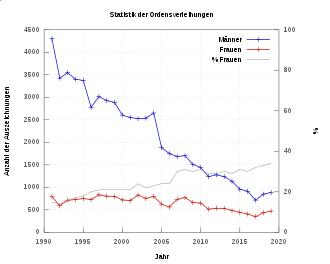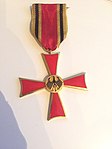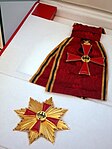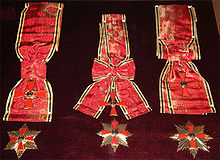Order of Merit of the Federal Republic of Germany
The Order of Merit of the Federal Republic of Germany , also known as the Federal Cross of Merit, is the only general merit award of the Federal Republic of Germany . It is awarded for special achievements in the political, economic, cultural, intellectual or voluntary field. The order is awarded in eight stages , including the Grand Cross in nine stages. All German states except Bremen and Hamburg also award their own orders of merit .
story
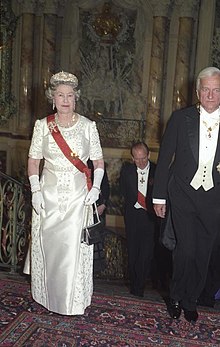
The Order of Merit of the Federal Republic of Germany on 7 September 1951 the then Federal President Theodor Heuss by decree donated. In the decree on the Foundation of the Order of Merit of the Federal Republic of Germany , which Heuss signed with Federal Chancellor Konrad Adenauer and Federal Minister of the Interior Robert Lehr , it says:
“With the desire to visibly express recognition and gratitude to well-deserved men and women of the German people and abroad, I am donating the Order of Merit of the Federal Republic of Germany on the 2nd anniversary of the Federal Republic of Germany.
The medal is awarded for achievements in the field of political, economic-social and intellectual work that served the reconstruction of the fatherland and is intended to mean an award to all those whose work contributes to the peaceful rise of the Federal Republic of Germany. "
The Order of Merit is awarded in three classes (Cross of Merit, Cross of Merit, Grand Cross) and several levels according to international standards.
In the statute of the Order of Merit of the Federal Republic of Germany of September 7, 1951, the following order was initially planned:
- Cross of Merit on ribbon
- Cross of Merit (without further designation as a plug-in cross, later renamed to 1st class)
- Great Cross of Merit
- Great Cross of Merit with a star
- Grand Cross
- Grand cross in a special design, the award of which was reserved for the Federal President.
The miner Franz Brandl from Nentershausen (Hesse) received the first Cross of Merit (as shown on the ribbon ) on September 19, 1951 from Theodor Heuss .
In 1952 there were some innovations: A special version of the Cross of Merit was introduced for blue-collar and white-collar workers who had worked for the same employer for 50 years . However, this version was discontinued in 1966. In addition, the Great Cross of Merit with a star was divided into two levels: Great Cross of Merit with Star and Great Cross of Merit with Star and shoulder ribbon .
Finally, in 1955, the medal of merit was added as the lowest level and the special level of the Grand Cross as the top level, which, however, had already been awarded in 1953.
The highest level, the special level of the Grand Cross, is reserved for heads of state and their family members and, upon taking office, for the German Federal President.
Award numbers
Since the proportion of women among the around 6,000 orders of merit awarded annually in the early 1980s, including around 1,000 foreigners at the time, was around 14 percent during the term of office of Federal President Karl Carstens (1979-1984), which prompted him to do so in the year 1983, to write in the new version of the implementing provisions for the statute of the Order of Merit that "special attention is to be paid to merits in activities which, after life experience, are mainly carried out by women".
In October 2006, the then Federal President Horst Köhler also introduced a quota system for women of at least 30 percent. This minimum was reached for the first time in 2007 at 30.3 percent and was maintained in the following years (2008: 31.2 percent; 2009: 30.5 percent). The proposal lists of the Prime Ministers of the federal states , through which the applications for orders are primarily submitted to the Office of the Federal President , are only accepted if at least three of ten people to be awarded the Order of Merit are women. If not enough women are proposed to the federal states to meet this quota, this resulted, for example, in Saxony-Anhalt (As of 2014) on the fact that men were not promptly proposed to the Federal President's office for honoring, but were placed on a growing waiting list and can only receive their award after a long waiting period.
Since 1991 the number of awards has fallen sharply. From more than 5,000 awards in 1991 and almost 2,500 awards in 2007, the number fell to 1,064 awards in 2017, roughly the same as in 1951.
The end of 2010 it was announced that since the mid-1990s, a not publicized agreement between the parliamentary groups there, since the pro legislature 30 medals are reserved regardless of actual earnings for members of parliament in accordance with the Group strengths. The constitutional lawyer Herbert von Arnim described this as “absolute presumption” and “completely new form of self-service”.
Levels of Merit
The Order of Merit of the Federal Republic of Germany is awarded in eight or nine stages (as of 2019). Another level was awarded from 1952 to 1966, it was called the Cross of Merit on Ribbon for Anniversaries .
| step | Strap buckle | Wearing style | features | International class |
annotation |
|---|---|---|---|---|---|
| Merit Medal | |||||
| Merit Medal |

|
left breast, on ribbon |
Medal (affiliated) |
→ List of sponsors | |
| Cross of Merit | |||||
| Cross of Merit on ribbon |

|
left breast, on ribbon |
Knight's cross | → List of sponsors | |
| Cross of merit on ribbon for long- service employees |

|
left breast, on ribbon with gold clasp |
golden clasp with the number 50 |
- | Awarded from 1952 to 1966 |
| Cross of Merit 1st Class |

|
left breast, cross |
Officer's Cross | → List of sponsors | |
| Great Cross of Merit | |||||
| Great Cross of Merit |

|
on the collar | Commander | → List of sponsors | |
| Great Cross of Merit with a star |

|
on the collar, breast star on the left |
four-pointed breast star, flat |
Grand Commander | → List of sponsors |
| Large cross of merit with star and shoulder ribbon |

|
on the shoulder band, breast star on the left |
four-pointed breast star, domed |
Grand Cross 2nd class |
→ List of sponsors |
| Grand Cross | |||||
| Grand Cross |

|
on the shoulder band, machine-embroidered eagle, breast star on the left |
six-pointed breast star | Grand Cross 1st class |
→ List of sponsors |
| Grand cross in a special design |

|
on the shoulder band, lined in red, machine-embroidered eagle, breast star on the left |
six-pointed breast star, laurel wreath around the medallion |
Grand Cross (special shape) |
→ List of sponsors (so far only Konrad Adenauer and Helmut Kohl ) |
| Special level of the Grand Cross |

|
on the shoulder band, hand-stitched eagle, breast star on the left |
eight-pointed breast star | → List of sponsors (only awarded to heads of state and their spouses, official insignia of the Federal President as monarch, highest form of the order) |
|
Federal Cross of Merit and Shoulder Ribbon (part of the "Great Cross of Merit with Star and Shoulder Ribbon", Theodor-Heuss-Haus )
Award


Every year more than a thousand people are honored on proposal. By July 18, 2019, the award had been presented a total of 258,515 times. In 2018, 1282 people were honored. In the case of an initial award, a maximum of the second level (cross of merit on ribbon) and a maximum of the first level (medal of merit) to people younger than 40 years of age is usually awarded. A higher level is only chosen in exceptional cases.
Principles
The Order of Merit of the Federal Republic of Germany cannot be awarded posthumously according to the ordinance law. Nevertheless, Jürgen Schumann and Dominik Brunner , for example, received the awards posthumously. In these cases, the circumstances of death are usually the reason for the award.
The first award is generally the Medal of Merit or the Cross of Merit on Ribbon. There is no minimum age to be awarded the Medal of Merit. For the Cross of Merit on ribbon, the person to be honored should be at least 40 years of age. The award of the next higher order level requires new achievements worthy of distinction and a corresponding intercalary period . An exception to these provisions is possible for particularly outstanding achievements.
Imparted by the Federal President Award is usually the prime minister , a minister of the Federation or of the country, the provincial government , the district administration , the mayor or the mayor presented. Foreign Germans and foreigners often receive it from the responsible German ambassador . In some cases, the Federal President will hand it out himself, mostly at higher levels.
Some officials , soldiers and judges were now automatically awarded certain degrees as soon as they leave their office. That was the case with the award of the Great Cross of Merit to the respective Inspector General of the Bundeswehr or with the award of the Great Cross of Merit with star and shoulder ribbon after the end of the term of office as judge of the Federal Constitutional Court .
Diplomats who leave their host country after a long stay receive the Cross of Merit in accordance with international custom: Ambassadors and some military attachés are honored without the usual examination procedure at medal awards. The Argentine Colonel Juan José Masi , military attaché at the Argentine embassy in Bonn from 1977 to 1980, who is accused of serious human rights violations, received the Grand Cross of Merit in this way in March 1981 .
The procedure of the public award is usually held in a festive manner, the highest award levels are personally carried out by the incumbent Federal President . Each honored person is introduced with some information about their life and work.
Right of proposal
Everyone can encourage another to be honored. To do this, he turns to the State Chancellery of the country in which the nominee is domiciled . If the person lives abroad or is a foreigner, the Foreign Office is responsible for the proposal. The award of an employee of a federal authority can be suggested to the responsible federal minister . The respective protocol department has the task of checking the information before it is forwarded to the Ordenskanzlei in the Office of the Federal President . In practice, above all authorities , institutions do, Business and sports associations suggestions. In contrast, suggestions from the population are rare: in North Rhine-Westphalia, the most populous federal state, an average of almost 850 awards were suggested between 2003 and 2012, more than half of which were actually carried out. The rejection rate in NRW averaged 42.1 percent. According to the limited data available from other countries, the rates there are similar.
In addition to the right to propose the award of the Order of Merit, there is also the suggestion to withdraw an already awarded Order of Merit.
Deprivation
Despite the previous test procedure, the award was also given to people who were later revoked. For example, Heinrich Bütefisch was proposed for the order by members of the Federation of German Industries in 1964 . The Düsseldorf Order Department apparently found nothing against him at the Constitutional Court and the Ministry of Justice, Bütefisch received the order - 16 days later it was stripped from him. A citizen had pointed out that Bütefisch had been sentenced to six years in prison in the IG Farben trial in 1948 for “exploiting the work of concentration camp inmates”.
Shape, material and manufacture
From the ribbon level onwards, the medal insignia is available in a different version for men and women. The women's versions are characterized by somewhat smaller crosses and medallions as well as a narrower ribbon (from the Great Cross of Merit level ), which is always designed as a women's bow.
| step | Men's version | Ladies version | ||||
|---|---|---|---|---|---|---|
| size | Size star | tape | size | Size star | tape | |
| Merit Medal | 38 mm | - | 30 mm | 38 mm | - | 30 mm |
| Cross of Merit on ribbon | 55 mm | - | 30 mm | 47 mm | - | 30 mm |
| Cross of Merit 1st Class | 55 mm | - | - | 47 mm | - | - |
| Great Cross of Merit | 60 mm | - | 44 mm | 60 mm | - | 40 mm |
| Great Cross of Merit with a star |
60 mm | 80 mm | 44 mm | 60 mm | 80 mm | 40 mm |
| Large cross of merit with star and shoulder ribbon |
60 mm | 85 mm | 100 mm | 60 mm | 85 mm | 60 mm |
| Grand Cross | 70 mm | 80 mm | 100 mm | 60 mm | 80 mm | 60 mm |
| Grand cross in a special design | 70 mm | 80 mm | 100 mm | 60 mm | 80 mm | 60 mm |
| Special level of the Grand Cross | 70 mm | 90 mm | 100 mm | 60 mm | 80 mm | 60 mm |
Because of the large number of items on the one hand and the cost consciousness on the other hand, the medals are now only machine- stamped from a copper alloy and provided with a gold coating ; colored parts are made of artificial enamel . Manufacturer of the official medals of the Federal Republic of Germany is the company Steinhauer & Lück in Lüdenscheid .
Previous carriers
So far, the Order of Merit of the Federal Republic of Germany has been awarded around 257,000 times (as of the end of 2017).
Wearing style
The grand cross is carried on a broad band from the right shoulder to the left hip. The corresponding golden star is worn on the left side of the chest.
The Great Cross of Merit is worn as a Great Cross of Merit with a star and a shoulder ribbon on a wide band leading from the right shoulder to the left hip. The golden four-pointed star belonging to the Great Cross of Merit with a star and shoulder ribbon is worn on the left side of the chest.
The Great Cross of Merit with a star is worn on a ribbon around the neck.
The merit cross is placed on the left side of the chest as a merit cross, 1st class, and worn as a merit cross on a ribbon on a narrow ribbon on the upper left side of the breast.
The medal of merit is worn on the ribbon on the upper left side of the chest.
Wearing the miniature ( ribbon bridge ); here: the Cross of Merit on ribbon
Hanseatic rejection
The Free Hanseatic City of Bremen was the only state to vote against the foundation of the Federal Order of Merit. Bremen and Hamburg are also the only countries that have not donated their own Order of Merit.
Bremen
It is not a Bremen custom to give or wear medals. The Senate of the Free Hanseatic City of Bremen once stated in 1893: “It has long been the custom that decorations from Senate members are never accepted, and so it is advisable - apart from other reasons - to adhere to this for that very reason. Also because the Bremen Senate is not in a position to respond to such courtesies. ”Mayor Theodor Spitta reaffirmed this custom in 1952 to Federal President Theodor Heuss . But there were and will be medals of honor such as the Bremen Medal of Honor or the Senate Medal for Art and Science of the Free Hanseatic City of Bremen(as in Hamburg) awarded. There was only one exception due to the war: the Hanseatic Cross was an award given during the First World War and was jointly donated in 1915 by the three Hanseatic cities of Hamburg, Bremen and Lübeck for services in the war.
Hamburg
According to a principle that dates back to the 13th century and was confirmed in a Senate resolution of 1963, some Hamburgers reject “awards from foreign gentlemen” ( Hanseatic and awards ). Former Senator Emilie Kiep-Altenloh had been proposed for the Great Cross of Merit . Thereupon there was a small inquiry of the SPD in the Hamburg citizenship in May 1963. Mayor Paul Nevermanndeclared that the Senate continues to stick to its traditional motto: no medals for senators. Regarding suggestions from other sources, the Senate will comment on the awarding body to the effect that the award should not be granted. The Free and Hanseatic City of Hamburg honored Emilie Kiep-Altenloh in 1963 with the Mayor Stolten Medal .
Well-known rejecters of the award were Helmut Schmidt , Hans-Olaf Henkel , Inge Meysel , Jan Philipp Reemtsma , Günter Grass , Heidi Kabel , Siegfried Lenz and Hans-Ulrich Klose .
literature
- Alexander von Sallach: The orders and decorations of our republic. Phaleristischer Verlag Autengruber, Konstanz 2004, 2006, ISBN 3-937064-05-2 , ISBN 3-937064-04-4 ; Edition 2011: Battenberg Verlag, ISBN 978-3-86646-079-9 .
- Birgit Laitenberger, Dorothea Bickenbach, Maria Bassier: German orders and decorations . 6th edition, Carl Heymanns Verlag, Cologne 2005, ISBN 3-452-25954-4 .
- Knut Bergmann: Who has, who is given? The Federal Cross of Merit as part of the public culture of recognition . In: Merkur , Volume 67, Issue 764, Issue 09, September 2013, pp. 844–850. ISSN 0026-0096.
- Knut Bergmann: Just the usual suspects? Orders and decorations as recognition and motivation for civic engagement . In: Wolfgang Lauterbach / Michael Hartmann / Miriam Ströing: (Ed.): Wealth, Philanthropy and Civil Society. Springer VS, Wiesbaden 2014, ISBN 978-3-658-06012-1 , pp. 133-152.
Web links
- Decree on the foundation of the "Order of Merit of the Federal Republic of Germany"
- Statute of the "Order of Merit of the Federal Republic of Germany"
- Brochure from the Office of the Federal President on the Order of Merit of the Federal Republic of Germany (PDF; 799 kB; 40 pages)
- The Order of Merit of the Federal Republic of Germany in ordensmuseum.de
- Statistics of the Order of Merit awarded by the Federal President from 2009 to 2019 in www.bundespraesident.de
- Spiegel Online: 60 years of the Federal Cross of Merit - The sheet metal avalanche (accessed on November 25, 2014)
Individual evidence
- ↑ Lars Amelung: First award of the Federal Cross of Merit of the Federal Republic of Germany 1951. In: Virtual exhibitions. At Bundesarchiv.de, accessed on October 6, 2019.
- ↑ See the decree on the Foundation of the Order of Merit of the Federal Republic of Germany of September 7, 1951, as well as the decree on the revision of the statute of the Order of Merit of the Federal Republic of Germany of December 8, 1955 (p. 1 and 2): Decree of 1951 , p. 1 , 2 .
- ↑ Hagen Eichler: Federal Cross of Merit - women's quota stops honoring men. In: volksstimme.de , June 13, 2014.
- ↑ Too few women, wrong earnings - why the Federal President awards fewer and fewer medals. In: Der Tagesspiegel , November 23, 2016, accessed on December 25, 2016.
- ↑ a b Statistics of the awards of medals .
- ↑ Members use themselves at merit crosses. In: Welt.de , accessed on December 30, 2010.
- ↑ The Federal President, Orders and Honors: The eight levels of the Order of Merit of the Federal Republic of Germany ; accessed April 3, 2019.
- ^ The Federal President: The Order of Merit of the Federal Republic of Germany .
- ↑ Steffen Leidel: Awarding practice of orders of merit in criticism. In: Deutsche Welle , April 14, 2005.
- ↑ Arno Widmann: The staging of the beauty of a society. The Federal President honors 15 men and 17 women with the Cross of Merit - including artists, churchmen and civil rights activists . In: Berliner Zeitung , 2./3./4. October 2015, p. 7.
- ↑ Knut Bergmann: Who has who is given? The Federal Cross of Merit as part of the public culture of recognition. In: Merkur, Volume 67, Issue 764, Issue 09, September 2013, pp. 844–850, 847.
- ^ Kerstin Artz: The Federal Cross of Merit turns 60. In: Rheinische Post , September 7, 2011, p. A6
- ↑ Spiegel Online : one day
- ↑ Order: Debit and credit . In: Der Spiegel . No. 15 , 1964 ( online ).
- ↑ www.bundespraesident.de: The Federal President / Order of Merit. Retrieved April 7, 2018 .
- ↑ Article 4 of the Statute of the Order of Merit of the Federal Republic of Germany. Retrieved January 8, 2017.
- ↑ https://www.ordenthw.de/shop/bundesverdienstkreuz/bandstege.html
- ^ Herbert Black Forest : The Great Bremen Lexicon . 2nd, updated, revised and expanded edition. Edition Temmen, Bremen 2003, ISBN 3-86108-693-X , p. 223.
- ↑ Also in the future no medals for senators ( Memento of July 27, 2014 in the Internet Archive ), In: Hamburger Abendblatt No. 119 of May 24, 1963, p. 3 (PDF; 1.5 MB).
- ↑ a b Lübecker Nachrichten , October 8, 2014, p. 3.

